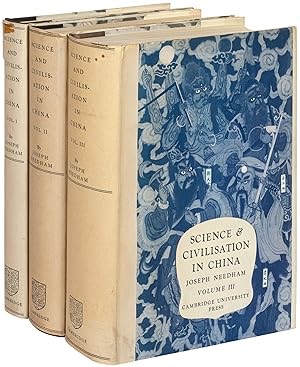
Joseph Needham consacre un volume entier de "Science et Civilisation en Chine » à l’alchimie interne et un chapitre aux 8 pièces de brocart de la famille des immortels.
Les Huit Morceaux de Brocart
Ci-après la présentation de ce Qi Gong par Katherine Allen, traduction en français de la Bible du Qi Gong (Ed. Trédaniel) et sa version originale en anglais tirée du même ouvrage.
Bruno Degaille a également étudié cet enchainement avec Dan Docherty.
Les Huit morceaux de brocart sont l’un des enchaînements les plus connus du Qi gong. lI a une longue histoire et est mentionné dans les textes anciens tels que « Les dix compilations sur la culture de la perfection (Xiuzhen Shishu), .v 1300.
Divers personnages ont été crédités de son invention, dont deux des Huit Immortels légendaires, Zhongli Quan et Lü Dongbin. L’enchaînement a aussi été attribué au semi-légendaire général Yue Fei, v. 1100, censé avoir enseigné ces exercices à ses troupes pour les garder fortes et prêtes pour la bataille. Transmis au fil des siècles, l’enchaînement dispose de nombreuses variantes.
Le brocart de soie est un tissu d'excellence, et on peut donc inférer que ces exercices étaient tenus pour être meilleurs. L'enchaînement fortifie le corps, améliore la flexibilité des tendons, nourrit le qi et équilibre l’énergie yin/yang dans le corps, favorisant ainsi sa longévité. La traduction de ba (« huit ») duan(« morceaux») et jin («brocart») pourrait aussi être un jeu de mots chinois, de par leurs significations supplémentaires : ba («stopper», «favoriser»,« capturer), duan («brisé», « affaibli ») et iin (« tendon », «muscle »). La tradition poétique chinoise offre typiquement une belle image du brocart de soie, tout en faisant en même temps allusion à la santé.
Ce style, que j'ai appris il y a des années, , est le style Ba duan jin (Xian Jia Ba Duan Jin), que m’a enseigné Dan Docherty, maître international de grande renommée. Il a appris de son maître CHENG Tin Hung, qui l’avait appris à son tour de son oncle CHENG Wing Kwong, , élève de Wu Jianquan. Ce style est moins connu que d’autres, mais il est accessible à tous. Il s’intéressa particulièrement les pratiquants. familiarisés avec des styles plus connus.
Cet enchaînement consiste en huit séquences, dont certaines comportent deux parties. Bien qu’il soit conçu pour être pratiqué comme un ensemble, on peut effectuer indépendamment n’importe laquelle de ses parties, selon les préférences. En tant qu’ensemble, l’enchainement règle l’énergie qi. Il convient aux débutants et aux pratiquants expérimentés et peut être modifié en cas de besoin. Même si la plupart des exercices sont présentés debout, ils sont faciles à adapter pour une position assise.
Extrait de : La Bible du Qi Gong - Katherine Allen
Eight Pieces of Brocade - Baduanjin
The Eight Pieces of Brocade is one of the best-known Qigong sets. It has a long history and is mentioned in ancient texts such as The Ten Compilations on Cultivating Perfection (Xiuzhen Shishu), c. 1300. Various people have been credited with its invention, including two of the legendary Eight Immortals, Zhongli Quan and Lü Dongbin. The set has also been attributed to the semi-legendary General Yue Fei, c. 1100, who is said to have taught the exercises to his troops to keep them strong and ready for battle. As a result of being handed down over the centuries, the set has gained many variations.
Silk brocade is a fabric of excellence, and we can therefore infer that these exercises were considered to be of the highest quality. The set strengthens the body, improves flexibility of the sinews, nourishes the Qi and balances the Yin-Yang energy in the body, thus promoting longevity. The translation of ba (eight), duan (pieces) and fin (brocade) could also be a Chinese pun because of the additional meanings of the syllables: ba (to pull up, promote, capture), duan (broken, weakened) and jin (tendon, muscle, sinew). It would be typical of the Chinese poetic tradition to offer a beautiful image of the silken brocade and at the same time imply a practical health allusion.
This style, which I learned many years ago, is the Immortal Family Style of Baduanjin, Xian Jia Baduanjin, taught to me by Dan Docherty, an international teacher of great renown. He learned from his teacher Cheng Tin Hung, who leared from his uncle Cheng Wing Kwong, who was a student of Wu Jianquan. The style is not as well known as some but is totally accessible to all. It will be of particular interest to those who are familiar with the better-known styles.
This set consists of eight sections, some of which have two parts. Although it is intended to be practised as a set, you can take any part of the set and practise it individually, according to your preference. The set as a whole regulates Qi energy. It is suitable for beginners and the experienced alike and can be modified where required. Although most of the exercises are shown standing, they can easily be adapted to a seated position.
Extract from : The Qigong Bible - Katherine Allen